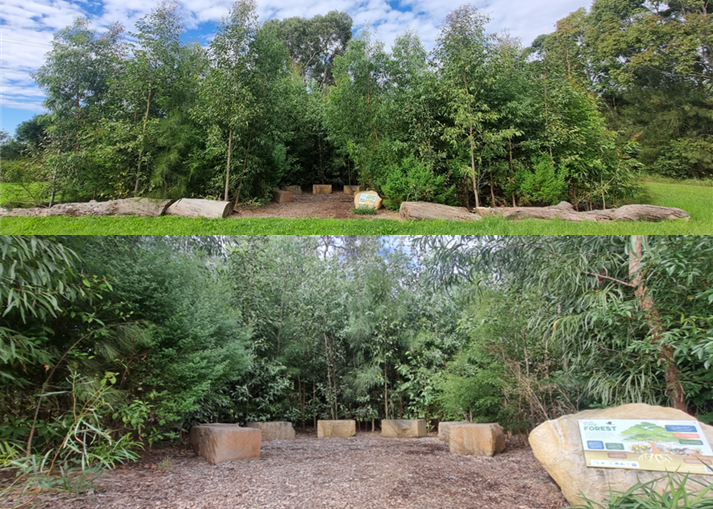Is my Landcare site a Tiny Forest? Well, not exactly.
Published on 13 May 2025

By Amy Trello, Landcare Support Officer
You might of have heard about Tiny Forests. They are popping up in communities and schools around Lake Macquarie, Australia and are all over the world. The concept of a Tiny Forest comes from Japan and has been around since the 1970s. Professor Akira Miyawaki developed the method after researching, testing and engineering a way to restore degraded land. This is why they are also often referred as the Miyawaki Forests. Tiny Forests are a way to create places for wildlife and the community. They capture carbon and slow water runoff during rain events and assist in combating the Urban Heat Island Effect, just to name a few benefits.
The question has been asked ‘Is my Landcare site a Tiny Forest’? Some might say my Landcare site is small and it doesn’t take up a lot of space and sometimes we plant close together so it could easily be described as a Tiny Forest. There are some similarities, so how is it different? To that, I say, well, it is similar but there are a couple key differences that will help determine if it’s a Tiny Forest or natural area (Landcare site).
Tiny Forests can be described as compact, densely planted, engineered ecosystems the size of a tennis court. The soil is improved with manures and composts and mixed and loosened using a machine. These enriched soils give nutrients to the plants allowing them to grow quickly. Tiny Forests are typically established in under-utilised areas which were bare and barren parcels of land.
This tiny forest in Teralba, pictured below, was planted in 2023 and was a large patch of mown grass. Some of the tallest trees are now 8 meters tall with many others not far behind.

A Landcare site in Lake Macquarie is generally a natural area, often near a water course or bushland. The soils here are typically old and nutrient poor. The NSW State Environmental Planning Policy 2021 states “bushland is land on which there is vegetation which is a remainder of the natural vegetation of the land or, if altered, is still representative of the structure and floristics of the natural vegetation”. Often, our Landcare sites can easily be defined by this. We usually have some mature native trees and vegetation that classify it to be bushland with a weedy midstory and understory. Native vegetation in these sites is more widely spaced, where competition for light and nutrient over years has determined the floristic structure and spacing between vegetation. These natural areas vary in their structure – they may only have one vegetation layer e.g. grassland, or a very open midstory e.g. Casuarina forests, or a dense one e.g. rainforest, which means there is great diversity across the landscape.
We go through our Landcare site daily, weekly or monthly looking for native regeneration, pulling weeds, assessing and reassessing the work we have done or are yet to do. This highlights another important difference. When we work on a Landcare site, the goal is predominately sustainability of that natural area. We want to remove weeds to let the natural area return to what it was prior to weedy invasion. If we do our job right, the site will maintain itself with only a small amount of weed control to keep it healthy. We work slowly, methodically and encourage natural regeneration where possible. Tiny Forests work on a much shorter timeline, hoping for maximum growth and minimal maintenance within as little as two years. When Landcare sites are planted, species are provided that fit in that particular vegetation community. Biodiversity is determined by soil composition, surrounding flora and fauna species, aspect and water availability. We aim to preserve the genetic lineage of the plants that have evolved in that exact location. This is called genetic diversity.
Regardless, a Tiny Forest or natural area (Landcare site) are both achieving physical, social, emotional, intellectual and spiritual interconnectedness. And it’s not all about us humans. These places are providing something for others, a service to anyone or anything around them, a place for protection, quiet, exploration, discovery and hope. Different ideas, different methods but all moving in the same direction.
Special thanks to the Landcare team, Groundswell Collective and ReLeaf Lake Mac for their contributions.